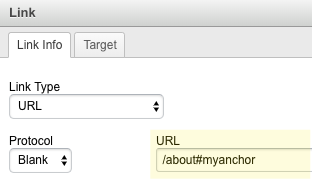

- #Replace anchor href with direct url serial number
- #Replace anchor href with direct url archive
- #Replace anchor href with direct url full
- #Replace anchor href with direct url code
This is pretty simple, just include one of the following snippets: ('new target URL') //or ('new target URL') I would recommend using replace because the original URL is not valid.
#Replace anchor href with direct url code
If you want to have the link use an image, switch out the text in the link with the code for an embedded image, like this: When composing your post or page, click the HTML tab in the toolbar and enter the anchor code at the beginning of the line where you want to jump. The anchor should be placed at the beginning of the line where you want to start reading after you jump similar to:įollowing our previous example, the anchor code will be: The second part of an anchor tag is the actual anchor. When composing your post or page, click the HTML tab in the toolbar and enter the link code.
#Replace anchor href with direct url full
If you want a link to jump a specific location on a different page, you'll need to replace #anchor with the full URL for the page, similar to: The above anchor link only works when you are jumping to a specified spot on the same webpage. If you are linking to a spot on the same page, the format of the link will be similar to:įor example, if the text is "Read more about raptors!" then your HTML should look like this: Read more about raptors! The anchor tag code will consist of two HTML elements.

You can link to the same anchor in multiple locations throughout the post or page. Click Insert Link and the link to the anchor will be inserted into the post. Once selected, the other fields for the link will be completed. Any anchors you have created in the post will be available to select from the Anchors menu. Next, you will place your cursor where you want the reader to be able to jump and click Insert Link to create your link. For example, if you want to place a link to jump back to the top of the page, you could name the anchor "top". This should be something simple, not include any spaces, and start with a letter.

You will prompted to add an ID for the anchor. Add links to elements on your site to help visitors navigate your content, and direct them to relevant and important content. In the Rich Text editor, place the cursor in the post where you wish to drop the anchor, open the Insert menu, and click Anchor. If you prefer to use HTML to code the anchor tags, click to the Anchor Tag Code section.įirst, you will need to place the anchor. With the Rich Text editor, you can place anchors in your posts.
#Replace anchor href with direct url serial number
#Replace anchor href with direct url archive
If the URL requires a login or is session-specific (meaning it will not resolve for readers), provide the URL of the database or archive home page or login page instead of the URL for the work.

Include a DOI for all works that have a DOI, regardless of whether you used the online version or the print version.Follow these guidelines for including DOIs and URLs in references:


 0 kommentar(er)
0 kommentar(er)
